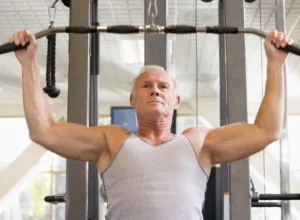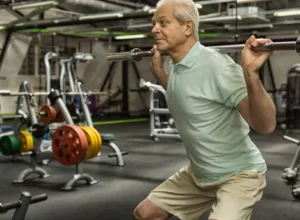As we age, our bodies undergo a series of natural changes. One of the most significant is the gradual decline in muscle mass and strength, often referred to as sarcopenia. While this process can begin as early as our 30s, it accelerates after 50, with estimates suggesting a potential loss of up to 30% of muscle strength between the ages of 50 and 70.
However, maintaining muscle strength in old age is enormously important in order to maintain mobility and to be able to lead an independent life and manage everyday tasks independently. Maintaining muscle strength in old age is important in order to maintain mobility and be able to lead an independent life and manage everyday tasks independently.
In the current issue of Deutsches Arzteblatt International, Frank Mayer and colleagues from the University of Potsdam conclude that progressive strength (resistance) training counteracts muscular atrophy in old age (Dtsch Arztebl Int 2011; 108(21): 359-64).
The authors investigated the extent of the effects that can be achieved by strength (resistance) training in elderly persons and which intensities of exercise are useful and possible in persons older than 60 years.
They found that regular strength (resistance) training increased muscle strength, reduced muscular atrophy and that tendons and bones adapt too.
This decrease can have a profound impact on our daily lives, affecting mobility, independence, and overall health.
Understanding Muscle Loss
Our muscles are made up of protein fibers that contract to generate force and movement. With age, several factors contribute to muscle loss:
- Reduced protein synthesis: The body becomes less efficient at building new muscle protein.
- Hormonal changes: Decreases in testosterone and estrogen, particularly after menopause, can lead to muscle loss.
- Decreased physical activity: As we age, we often become less active, which further accelerates muscle loss.
- Inflammation: Chronic inflammation, a common feature of aging, can damage muscle tissue.
The Consequences of Muscle Loss
The loss of muscle strength after 50 isn’t just a cosmetic concern. It can have significant consequences for our health and well-being:
- Reduced mobility and independence: Weaker muscles make it harder to perform everyday tasks, such as climbing stairs, carrying groceries, or getting up from a chair. This can lead to a loss of independence and an increased risk of falls.
- Increased risk of injuries: Weaker muscles are more susceptible to injury, especially during falls.
- Metabolic slowdown: Muscle tissue plays a crucial role in metabolism. Reduced muscle mass can lead to a slower metabolism and weight gain.
- Decreased bone density: Muscle weakness can put additional stress on bones, increasing the risk of osteoporosis.
Check Out Our List Of The Best Supplements For Building Muscle, Shredding Muscle, Recovery, And Great Health, and Wellness Products! Purchase ifbnewsfeed.org‘s apparels Here: ifbnewsfeed.org
 The Good News: You Can Fight Back!
The Good News: You Can Fight Back!
The good news is that muscle loss after 50 is not inevitable. Here are some key strategies to combat sarcopenia and maintain your strength:
- Strength Training: This is the single most effective way to build and maintain muscle mass. Aim for strength training exercises that target all major muscle groups at least twice a week. Start with bodyweight exercises or light weights and gradually increase the intensity as you get stronger.
- Protein Rich Diet: Consuming enough protein is essential for muscle growth and repair. Aim for 0.8-1 gram of protein per kilogram of body weight per day. Include lean protein sources like chicken, fish, beans, and lentils in your diet.
- Stay Active: Regular physical activity, even if it’s not intense strength training, helps to maintain muscle mass and overall health. Aim for at least 150 minutes of moderate-intensity exercise per week, or 75 minutes of vigorous exercise.
- Maintain a Healthy Weight: Being overweight or obese can worsen muscle loss. Focus on maintaining a healthy weight through a balanced diet and regular exercise.
- Get Enough Sleep: When we sleep, our bodies repair and rebuild tissues, including muscle. Aim for 7-8 hours of quality sleep each night.
These successes in turn had a preventive effect in terms of avoiding falls and injuries.
Greater intensities of training yielded greater effects than moderate and low intensities.
In order to increase muscle mass, an intensity of 60-85% of the one-repetition-maximum is required.
In order to increase rapidly available muscle force, higher intensities (>85%) are required.
The optimum amount of exercise for healthy elderly persons is 3 to 4 training units per week.
In the coming decades, the importance of maintaining the ability to work and to make a living will increase, as will the need for independence in everyday life and leisure activities.
The increase in the retirement age to 67 years from 2012 means that one in three adults of working age will be older than 50 by 2020, and by 2050, the proportion of people older than 60 in Germany’s population will rise to an estimated 40%.
Currently, the proportion of elderly persons who practice strength (resistance) training is about 10-15%.
 Additional Tips How To Fight Back The Muscle Loss:
Additional Tips How To Fight Back The Muscle Loss:
- Talk to your doctor: Before starting a new exercise program, especially if you have any health concerns, it’s important to consult with your doctor.
- Consider working with a trainer: A certified personal trainer can help you design a safe and effective strength training program tailored to your needs and goals.
- Make it a habit: Consistency is key to building and maintaining muscle mass. Make strength training and physical activity a regular part of your routine.
Wrapping Up
Muscle loss after 50 is a natural part of the aging process, but it’s not something we have to accept passively. By incorporating strength training, a protein-rich diet, regular physical activity, and healthy lifestyle habits into your routine, you can combat sarcopenia and maintain your strength, mobility, and independence well into your golden years. Remember, it’s never too late to start! Take charge of your health and invest in your future by prioritizing muscle-building strategies.
More About The Muscle Loss Guide Contents:
- People Lose “30% Of Their Muscle Strength” Between The Ages Of 50 And 70 years
- The “5 Best Bodyweight Exercises” To Build Muscle, Build Strength, Build Stability And Stay Stronger

- A1Supplements.com – America’s Favorite Supplement Store.
- Shop Optimum Nutrition Energy: Anytime & Pre-Workout
- A1Supplements.com – Lose Fat, Gain Muscle!







